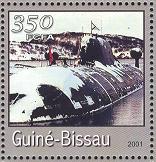|
Soviet`s Akula class, Project 971, SSN-nuclear powered attack submarine
 Designated the Akula class by the West (Russian for shark), the submarine is officially designated Project 971M/Shchuka-B (meaning pike)- attack submarine multi-purpose submarine is capable of strikes against groups of hostile ships and against coastal installations. The Project 971, using a steel hull, was initiated in 1976 when it became evident that existing industrial infrastructure was inadequate to mass produce the expensive titanium hulls of the Project 945 Sierra class. The performance of the Project 971 boats was a close approximation to that of the Project 945 design, though the later was significantly more expensive to build and maintain. It has 650 mm and 533 mm torpedo tubes which can use mines as well as Granat cruise missiles, antisubmarine missiles, and torpedoes. Designated the Akula class by the West (Russian for shark), the submarine is officially designated Project 971M/Shchuka-B (meaning pike)- attack submarine multi-purpose submarine is capable of strikes against groups of hostile ships and against coastal installations. The Project 971, using a steel hull, was initiated in 1976 when it became evident that existing industrial infrastructure was inadequate to mass produce the expensive titanium hulls of the Project 945 Sierra class. The performance of the Project 971 boats was a close approximation to that of the Project 945 design, though the later was significantly more expensive to build and maintain. It has 650 mm and 533 mm torpedo tubes which can use mines as well as Granat cruise missiles, antisubmarine missiles, and torpedoes.
The submarines feature double hull construction, dramatically increasing the reserve buoyancy of the submarine by as much as three times over that of a single hull craft. Ballast tanks and other gear are located between the inner and outer hulls, and limber holes are provided for the free-flooding sections between the hulls. Akula class submarines incorporate limber hole covers that can be closed to reduce or eliminate this source of unwanted noise.
Built to engage surface task forces and coastal facilities, the Akula submarine design was under constant upgrade. Western designated the Project 971/Soviet Bars boats as Akula I, and the Project 971U/Soviet Shchuka-M as Improved Akula I while Project 971A was designated Akula II. According to some reports the Akula-II class has a 3.7 meter longer hull to accommodate a quieter propulsion system.
The Akula is the quietest Russian nuclear submarine ever designed, and the low noise levels came as a surprise to Western intelligence. Russia claims the Akula is the quietest of its domestically built submarines and is fitted with acoustic countermeasure equipment. Noise reduction efforts include rafting the propulsion plant, anechoic tiles on the outside and inside of the hulls and possibly other measures such as active noise cancellation. The Project 971 is said by Russian sources to be at a distinct disadvantage in sensors, with a sonar suite that is roughly one-third as sensitive as the Los Angeles, able to track only two targets simultaneously (as opposed to the multiple target tracking capabilities of the American system).
The Akula can launch a range of anti-submarine and anti-surface vessel torpedoes. The submarine has eight torpedo launch tubes, four 650mm and four 533mm tubes. The Improved Akula (Project 971U) and Akula II (Project 971A) have ten, with six 533mm tubes. The four 650mm tubes can be fitted with liners to provide additional 533mm weapon launch capacity. The torpedo tubes can be used to launch mines instead of torpedoes. The Akula Class carry up to twelve Granat submarine launched cruise missiles. The missiles are fired from four 533mm torpedo launch tubes. The submarine`s anti-ship missiles are the Novator SS-N-15 Starfish and the Novator SS-N-16 Stallion and an air defence capability is provided by the Strela SA-N-5/8 portable missile launcher with 18 missiles.
Specifications, Akula class, Project 971:
Designed by G.N. Chernyshev at Malakhit, some 110 meters long, the Akula is double-hulled with considerable distance between the outer and inner hulls to reduce the possible damage to the inner hull. The hull is constructed of low magnetic steel, and divided into eight compartments, and features a distinctive high aft fin.
Displacement (srf/sub tons): 7,500/9,100
Dimensions (L*B*D feet): 360`1*45`9*34`1
Propulsion: 1*190MWt OK-650B Pressurized Water Reactors (PWR), 1*OK-7 geared steam turbine 43,000hp, one shaft 7 bladed propeller
Speed (sub knots): 28+
Range (srf/sub miles@knots): not relevant
Diving depth (feet): 1,475 (450m)
Complement: 25-31 officers 26-31 enlisted
Missile: SLCM sub-launched cruise missiles, Reduga SS-N-21 Sampson/Granat (1,620 n/miles nuclear warhead 200kT)
SSM sub-launched anti-ship missiles, SS-N-15 Starfish/Tsakra (24 n/miles nuclear warhead 200kT), Novator SS-N-16 Stallion (54 n/miles nuclear warhead 200kT), SS-N-27 Alfa (97 n/miles conventional warhead 200kg)
Torpedo: 4*21" (533mm) bow torpedo tubes, 4*25.5" (650mm) bow torpedo tubes, Improved Akula and Akula II: additional 6*21" external bow torpedo tubes, total mixture of 40 missiles or torpedoes
Armament: none
Mines: none
Construction
The submarines were built by the Amur Shipbuilding Plant Joint Stock Company at Komsomolsk-on-Amur and in Shipyard 402 at the Severodvinsk. Eight Akula class submarines were built in Komsomolsk until activities there ceased in 1993. All sources are in agreement that a total of seven Akula I submarines were built. These boats were all commissioned between 1985-86 and 1992. The prototype K-284 was decommissioned in 1995 to avoid the expense of a reactor refueling, and is generally not expected to return to service.
At least two and perhaps as many as four Improved Akulas entered service between 1992 and 1995. An additional Improved Akula I the K-267, Drakon, was launched in 1994 and delivered to the Russian Navy in 1995, though subsequently repossessed by the shipyard due to lack of payment. The boat reportedly remained in the possession of the Komsomolosk yard, which was said to be trying to sell her. According to some sources at least one and probably two additional Akula-Is remained undelivered at Komsomol`sk-na-Amur.
Back to History Index
 |
Guinea-Bissau |
2001 |
Akula class (type 971), SSN |
|